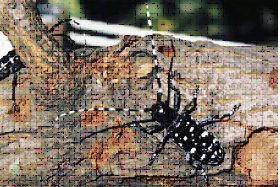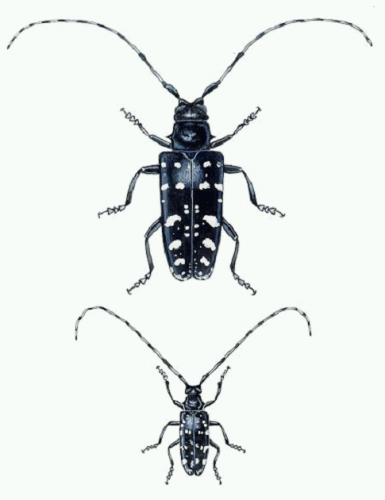Asian Longhorned Beetle
 Asian Longhorned Beetle (ALB) has been found in Massachusetts, and although it’s not time to be Chicken Little, “the sky is falling” it is appropriate to provide insight as to what this means for our community forests.
Asian Longhorned Beetle (ALB) has been found in Massachusetts, and although it’s not time to be Chicken Little, “the sky is falling” it is appropriate to provide insight as to what this means for our community forests.
The Asian Longhorned Beetle (Anoplophora glabripennis) has been positively identified in an infestation in the Greendale section (northeast sector) of Worcester, MA. Personnel from the USDA and Massachusetts Department of Agricultural Resources  (MDAR) inspected the site on Saturday August 2, 2008 and discovered the infestation. The inspection was prompted by the keen observations and persistence of a local resident who suspected the presence of this exotic invader.
(MDAR) inspected the site on Saturday August 2, 2008 and discovered the infestation. The inspection was prompted by the keen observations and persistence of a local resident who suspected the presence of this exotic invader.
Positive verification occurred on Tuesday (8/5/08) from the authority at the USDA Systematic Entomology Laboratory in Beltsville, MD. As result of the detection, portions of Worcester and portions of the towns of Shrewsbury, Boylston, West Boylston, and Holden are now a regulated area for the movement of woody plant material. A Federal Order will be issued soon that parallels the state regulated area. As part of the process of eradicating the ALB from Worcester, the movement of woody debris, lumber, firewood, and nursery stock that could host ALB infestations will need to be contained. This will keep the beetle from moving via human transport.
Local tree companies, Tree Wardens and Arborists that work with host material will be contacted by officials.
The ALB prefers all species of maple (sugar, Norway, red, and silver), box elder, horse chestnut, birch, willow, elm, ash, London plane, poplar and European Mountain Ash trees. All of these trees are found commonly in our community forests. It is an invasive species, native to China. It was first discovered in the United States in New York in 1996 and also has been found in Chicago and New Jersey. The beetles cause damage by tunneling with in the trunks and branches of trees disrupting the sap flow and eventually killing them. The female beetle is large, approx 1.5” long with 2” long antennae, Black with white spots. The male is slightly smaller, about 1” with similar white spots. (See photo) Other native beetles somewhat resemble this invasive beetle for comparison photos click here.
Photos courtesy of the USDA
The ALB has one generation per year. Adult beetles are usually present from July to October, but can be found later in the fall if temperatures are warm. Adults usually stay on the trees from which they emerged or they may disperse short distances to a new host to feed and reproduce. Each female is capable of laying up to 160 eggs. The eggs hatch in 10-15 days and the larvae tunnel under the bark and into the wood where they eventually pupate. The adults emerge from pupation sites by boring a tunnel in the wood and creating a round exit hole in the tree.
Only cursory surveys have been conducted thus far and the exact area regulated would change if more infested trees are found. Organized and thorough survey work will begin soon. The estimation, right now at least, for how long this beetle may have been active at this location is thought to be 5 years given its range and visible damage. Affected trees will be cut down, chipped and burned in the regulated area. This will not begin until after the first hard frost kills any remaining adult beetles. To take trees down before the hard frost risks spreading the infestation. This is a sound practice, as adult beetles tend to stay on the same tree unless that tree is severely infested.
 The control for ALB is drastic and dramatic. All identified infected trees will be cut down, chipped and burned within the effected area. All other trees showing no signs of infestation will be sprayed with an insecticide for three consecutive years. Only after 4 years of testing showing no new signs of the beetle will it be considered eradicated. A quarantine on the movement of wood and wood products is also placed on the infected area. This means that firewood, timber logs, wood chips etc cannot leave the area.
The control for ALB is drastic and dramatic. All identified infected trees will be cut down, chipped and burned within the effected area. All other trees showing no signs of infestation will be sprayed with an insecticide for three consecutive years. Only after 4 years of testing showing no new signs of the beetle will it be considered eradicated. A quarantine on the movement of wood and wood products is also placed on the infected area. This means that firewood, timber logs, wood chips etc cannot leave the area.
As noted above, it is believed the ALB has been in the Worcester area for 5 years. What is more significant is that this is the first known infestation outside of a major seaport area. This is also cause for concern, as the potential for other infested areas may be located near industrial sites/cities that use containerized shipping.
If you suspect you have located an Asian longhorned beetle please follow these steps: and immediately notify:
Massachusetts Department of Agricultural Resources (MDAR)
Report ALB sightings here or call 617–626–1779 (Pest Alert Hotline)
1) Record very carefully the location of your find, including the specific tree, the Property owner, the address or location of the property and the town. Also, record the date and time of day of the find, and who was there when the insect was witnessed. Please, write all of this down!
2) Do not collect the insect unless you are absolutely sure that you can prevent its escape. It is much better to let the inspectors come out to the site to make the identification rather than to risk spreading the infestation to a new site. Only collect the insect if you can place it in a tightly sealed, glass jar with a metal lid or other container that the insect cannot chew its way out of. Alternatively, you may kill the insect by freezing it for at least two days or by immersing it in alcohol. If you cannot guarantee that the insect will not escape, do not collect it – it is simply too risky!
3) Along those same lines, do not bring wood samples in for identification. Firewood removals and other type of wood transport have been among the primary means for spread of these insects. Instead, store the wood securely on site so that investigators may examine them later for signs of the insect or disease in question.
4) Please, do take pictures, make notes and collect any other observations that might help with the identification of the insect. If the insect is, indeed, one of the invasive pests, the MDAR will confirm the identification of the insect and formulate a response plan.
Your assistance in helping to prevent the further spread of an invasive insect will be greatly appreciated by all who value our trees and forests, and is of the utmost importance. We do not want to add maples to the list of American Elm, American Chestnut, and Eastern Hemlock, trees that are gone or under severe attack because of insects and disease. The Tree Warden’s page on the Town’s website will be kept updated with the latest information on this infestation.
In addition to the sites listed above, other resources for Asian Longhorned Beetle Information:

